Siege of Fort St. Philip (1815) facts for kids
Quick facts for kids Siege of Fort St. Philip |
|||||||
|---|---|---|---|---|---|---|---|
| Part of battle of New Orleans and War of 1812 | |||||||
 Fort St. Philip, overgrown in the mid 20th century |
|||||||
|
|||||||
| Belligerents | |||||||
| Commanders and leaders | |||||||
| Strength | |||||||
| 1 sloop-of-war 1 brig-of-war 1 schooner 2 bomb vessels 2 bumboats |
163 infantry 84 militia 40 sailors 117 gunners 35 artillery pieces 1 fort 1 gunboat Total: 406 |
||||||
| Casualties and losses | |||||||
| none documented | 2 killed 7 wounded 1 fort damaged |
||||||
The Siege of Fort St. Philip was a ten-day attack by the British Navy on an American fort. It happened during the final days of the War of 1812. British ships fired exploding shells from far away at Fort St. Philip in Louisiana.
At first, the fort couldn't shoot back because the British ships were too far away. The fort's cannons couldn't reach them. Also, the fort's own mortar (a type of cannon that fires shells high into the air) didn't have the right ammunition.
Later, supply boats brought the needed ammunition to the fort. On January 17, the fort started firing back at the British ships. The British then decided to leave. This battle took place on the Mississippi River.
Contents
Why Did the British Attack Fort St. Philip?
In August 1814, a British admiral named Cochrane wanted to attack New Orleans. He believed this would make the Americans give up in the war. The Royal Navy started a plan to capture New Orleans.
The waters around New Orleans were shallow and protected by American gunboats. The main way to reach New Orleans by river was through the Mississippi River. Fort St. Philip was built to defend this important river path.
How Was Fort St. Philip Built?
The fort was first built in 1795 by the Spanish. It was described as a strong, irregular shape, almost impossible to reach. Today, you can only get to it by boat or helicopter.
The fort had many cannons:
- Twenty-nine 24-pound cannons
- One 6-pound cannon
- Two howitzers (a type of short cannon)
- One large 13-inch mortar
- Two powerful 32-pound cannons placed low, near the water
In total, 35 cannons were used. An American Navy gunboat also waited nearby.
Preparing the Fort for Battle
In October 1814, American gunners fixed old cannon carriages. They also moved some cannons to better spots in the fort. The Americans built a signal station three miles downriver. This station would warn them if British ships were coming. They also built an earthen wall behind the fort for extra defense.
They added a new battery (a place for cannons) for the fort's mortar. They also thought about building a battery on the other side of the Mississippi River. This would help protect both sides of the river passage.
General Jackson, a famous American commander, ordered more defenses in December. He wanted a battery on the other side of the river and a stronger mortar battery at the fort. However, the riverside battery wasn't finished when the British arrived.
Engineers also added roofs over the fort's gun batteries. This was to protect the gun crews from exploding shell pieces. They replaced the old powder magazine (where gunpowder was stored) with several new ones. These new magazines had wood and dirt piled on top for protection. The idea was that if one was hit, the others would still be safe.
Around December 15, Major Walter H. Overton became the commander of Fort St. Philip. The fort got more soldiers, including a company of the 7th Infantry and 30 volunteer militiamen. The American soldiers were mostly infantry (foot soldiers) and 117 artillerymen to operate the cannons.
The British Approach
On January 1, 1815, Major Overton learned that British ships were coming. On January 8, a lookout boat arrived to confirm the British were very close.
The British ships had been ordered to sail up the Mississippi River on December 30. It took them from January 5 to January 7 to cross the shallow water at the river's mouth. One ship, HMS Herald, even got stuck on the sandbar. It then took them until January 9 to travel forty miles upriver to the fort. They had to pull and tow their ships hard to get there.
The British fleet included:
- HMS Herald (a ship with 18 guns)
- HMS Thistle (a brig-of-war with 12 guns)
- HMS Pigmy (a schooner with 10 guns)
- Two bomb vessels: HMS Aetna and HMS Volcano
These bomb vessels were important because they carried mortars. Mortars could fire exploding shells from a long distance. The British wanted to use these to bombard the fort and create a distraction. A larger British ship, HMS Nymphe, was too big for the shallow waters and couldn't join the attack.
The Siege Begins
On January 9, the five British ships were clearly seen at 10:15 AM. Around noon, two smaller British boats came closer to measure the river's depth. The fort's 32-pound cannons fired at them, forcing them to retreat. This showed the British how far the fort's cannons could shoot.
At 1:00 PM, American soldiers left the signal station. By 2:00 PM, a British landing party took it over.
The British ships anchored about two and a quarter miles (3,960 yards) south of the fort. In the afternoon, the two bomb vessels moved closer, to about 3,700 yards from the fort. At 3:30 PM, the bombardment began.
First Days of Bombardment
The British fired many mortar shells at the fort. Some reports say the shelling continued day and night, but others disagree. HMS Volcano's log shows it fired 50 shells on the first day. Many shells landed in the wet, marshy ground and didn't explode. Some exploded underground, causing tremors but little damage.
During the first day, no American soldiers were hurt. Some American accounts claim British rowboats came close at night, firing at the fort. This was supposedly a trick to distract the Americans so the main British ships could pass. However, the Americans were not fooled, and the rowboats left. The bomb vessels kept firing from a distance.
On January 10, the bombardment continued. HMS Volcano fired 80 shells that day. The fort occasionally fired back on January 9 and 10, but their cannonballs fell short of the British ships. On January 11, the fort fired for fifteen minutes, but again, their shots had no effect.
Flag and Fort Damage
On the morning of January 11, four British rowboats approached the fort. They fired howitzer shells and cannonballs before returning to their fleet. Later that day, a British shell hit the American flag pole. An American sailor bravely climbed the mast under fire to fix the flag. He managed to do it without getting hurt.
That evening, the British bomb vessels fired at the fort's storehouse. They thought it was the powder magazine. Several shells went through the storehouse. Two exploded inside, killing one American soldier and wounding another. The real powder magazines were mostly safe, except for some minor damage to the main one. HMS Volcano fired 92 shells that day.
The bombardment continued from January 12 to January 14. On January 12, HMS Volcano fired 56 shells until one of its own mortars burst. No one was hurt, and the ship was repaired overnight.
Changing Tactics and Reinforcements
By January 14, the British realized their shells weren't doing enough damage. Some thought they changed their shells to explode in the air. This would shower the fort with shrapnel (small metal pieces). This caused another American death and more wounded soldiers. The shells also damaged some of the fort's gun carriages. HMS Volcano fired 30 shells and three special incendiary shells (called carcasses) that day. These managed to silence one of the American 32-pound cannons for an hour until it was repaired. That night, British shells severely damaged the blacksmith's shop.
By the night of January 15, the American soldiers had built better defenses around their cannons. They used wood brought from nearby forests. The powder magazines were also made stronger with more layers of dirt. It had been raining a lot, and the inside of the fort was flooded. All the soldiers' tents were ripped by shell fragments, but no one was in them.
That evening, several supply boats arrived at the fort. They had traveled 65 miles upriver from New Orleans. They brought ammunition and, most importantly, fuses for the fort's broken mortar. This greatly improved the spirits of the American soldiers. They were now in a much better position to defend the fort.
The Fort Fights Back
On the morning of January 17, the British bombardment seemed less intense. In the evening, the fort's mortar was finally ready. It began firing back at the British bomb vessels. At one point, an American mortar shell hit one of the British bomb vessels. This put the ship out of action for five minutes. In response, the British fired more intensely into the night.
The mortar duel continued through the night of January 17 and into the early morning of January 18. Several shells landed in the fort's walls. One shell burst through a ditch and into the center of the fort. These were the last shots the fort received. At 6:00 AM, the British ships turned south and sailed down the river. By the afternoon of January 22, they had left the Mississippi River.
What Happened After the Siege?
General Jackson sent a report on January 19. He mentioned that the British fleet failed to pass Fort St. Philip. Some historians believe this stopped the British from moving their larger ships up the river to help their land attack. However, other historians disagree. They point out that most of Cochrane's large ships were too big for the shallow waters at the river's mouth. The largest ship in the attack on the fort was much smaller.
The British left once the fort's mortar was resupplied and could fire back. The British themselves described their attack as "unsuccessfully bombarding" the fort. The British attack was likely meant as a "diversion." This means they wanted to keep American soldiers busy at the fort. This would stop those soldiers from going to help fight elsewhere.
Major Overton claimed the British fired over 1,000 mortar shells. One estimate said this was 70 tons of ammunition. After the siege, the Americans found over 100 unexploded enemy shells buried inside the fort. Most of the fort's buildings were ruined. The ground for half a mile around the fort was full of bomb craters.
Two American soldiers were killed and seven were wounded. The fort itself was badly damaged. The British did not record any casualties. British historians have not focused much on this battle.
The incomplete battery across from Fort St. Philip was later replaced by a larger fort called Fort Jackson. Both Fort Jackson and Fort St. Philip were attacked again during the American Civil War.
Images for kids





